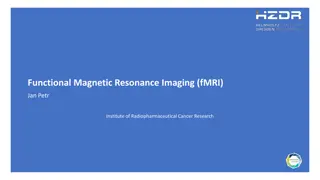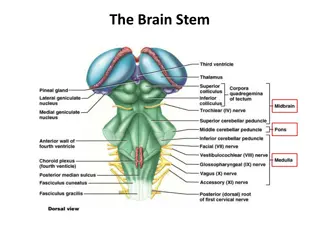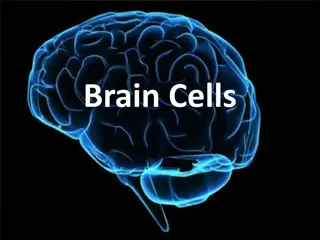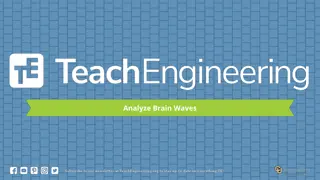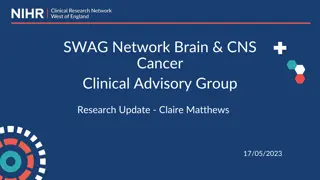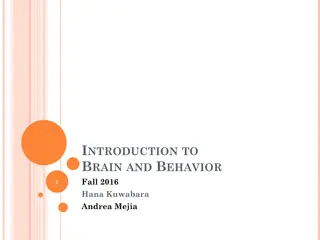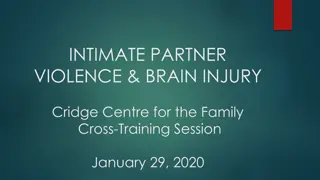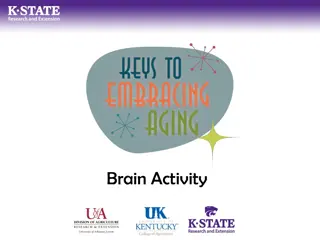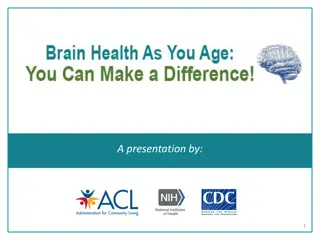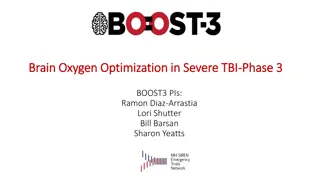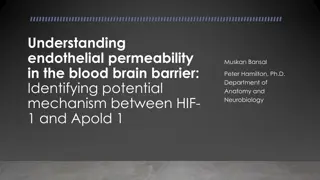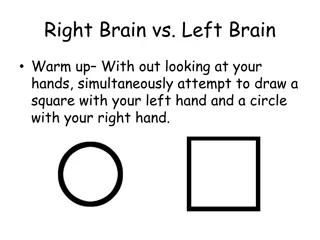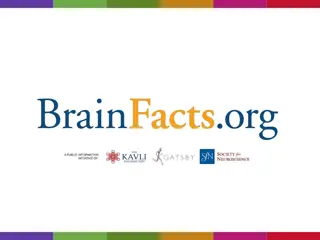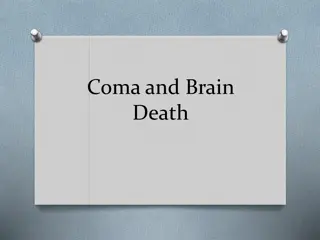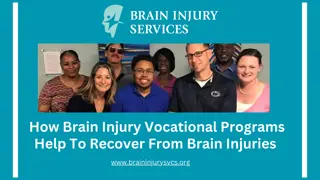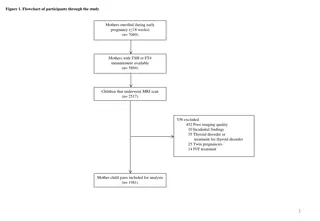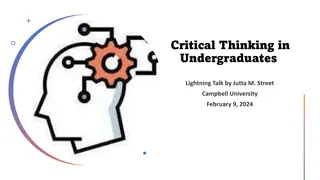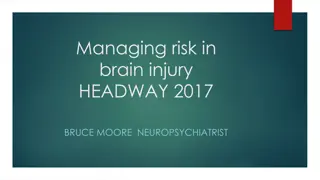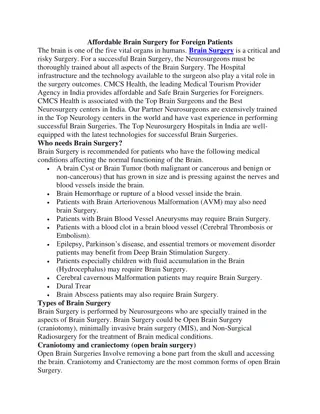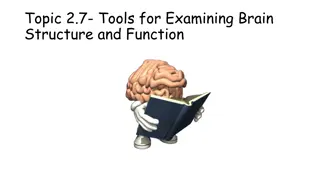Understanding Brain Waves: Frequencies and Behaviors
Brain waves are electromagnetic signals produced by the brain, categorized by frequencies into Delta, Theta, Alpha, and Beta waves, each associated with different states of consciousness and behaviors. These waves play a crucial role in our brain's energy utilization and overall functioning.
1 views • 11 slides
Revolutionizing Brain Health Monitoring and Intervention with AI
Willow Health presents an innovative AI companion, Willow, designed for personalized brain health monitoring and intervention. Their team, comprising students, scientists, doctors, and entrepreneurs, is dedicated to advancing brain health through continuous monitoring and improvement using digital a
2 views • 17 slides
Comprehensive Overview of Brain Imaging Techniques and Anatomy
Explore the world of brain imaging with functional MRI, MRI techniques, brain anatomy, neuronal activation, and brain vasculature explained in detail, shedding light on brain regions and their functions.
9 views • 53 slides
Understanding the Brain Stem and its Functions
Explore the intricate structures of the brain stem, including the midbrain, pons, and medulla oblongata. Learn about the functions of the cerebellum, its role in controlling postural reflexes and producing skilled movements. Discover the thick tracts connecting the cerebellum to the brain stem and t
8 views • 20 slides
Understanding Brain Development and Decision-Making Skills
Explore the fascinating realm of brain development and decision-making skills, focusing on how different brain regions activate during decision-making, the evolution of decision-making abilities from adolescence to adulthood, the importance of practicing decision-making skills, and the influence of
6 views • 10 slides
Understanding the Brain: Stem, Midbrain, Pons, Medulla, and Cerebellum Functions
Explore the complex structures and functions of the brain, including the brain stem, midbrain, pons, medulla, and cerebellum. Discover how these regions play crucial roles in controlling reflexes, movements, and vital functions like respiration and posture. Learn about the thick tracts connecting th
7 views • 21 slides
The Truth Revealed Does Cannabis Harm Brain Cells.docx
The Truth Revealed: Does Cannabis Harm Brain Cells?\nIn recent years, the debate surrounding the effects of cannabis on brain health has intensified. With the growing popularity of cannabis and the increasing accessibility of products from online weed dispensaries and marijuana dispensaries, it\u201
9 views • 3 slides
Understanding Trauma, Stress, and Behavior: Insights from Research on Growing Up and Promoting Self-Regulation
Explore the impact of trauma, stress, and behavior on individuals through a contextual approach based on research findings. Learn about two types of individuals exhibiting antisocial behavior, the effects of social exclusion on brain function, and the influence of racial discrimination on brain micr
3 views • 20 slides
Understanding Neuroplasticity: 10 Principles for Brain Rehabilitation
Explore the 10 principles of neuroplasticity for brain rehabilitation, including key concepts like "use it or lose it," specificity of exercises, and the importance of salience and intensity in therapy. Learn how practicing skills can strengthen neural connections and how therapists can help manage
6 views • 13 slides
Brain Injury Services: Empowering Recovery and Support
At Brain Injury Services, we are committed to making a positive difference in the lives of individuals affected by brain injury. Through our comprehensive support services, compassionate care, and commitment to empowerment, we empower survivors to overcome obstacles, reclaim their independence, and
6 views • 7 slides
Brain Cells
Delve into the fascinating world of brain cells and neurons to understand their structure, function, and communication process. Explore the microscopic level composition of the brain, the significance of neuron shapes, and the intricate workings of synapses in transmitting signals between neurons. U
1 views • 14 slides
Exploring Brain Waves Through EEG Analysis
Delve into the world of brain waves with EEG, EKG, and EMG measurements. Learn how to analyze brain wave data using mathematical processes like Fast Fourier Transform (FFT) and Power Spectral Density (PSD). Discover the significance of different frequencies in brain wave signals and how they reflect
1 views • 13 slides
Latest Research Updates on Brain and CNS Cancer Studies
SWAG Network Brain & CNS Cancer Clinical Advisory Group provides research updates on national brain cancer recruitment, national vs. regional recruitment, and ongoing brain cancer studies in the SWAG region. Additionally, insights from the Cancer Patient Experience Survey 2021 shed light on patient
0 views • 10 slides
Understanding the Brain and Behavior in Fall 2016
This content delves into the intricacies of the brain and behavior, covering topics such as the organization of the brain, the nervous system, brain stem functions, disorders of the cerebellum, and the forebrain components. It provides a detailed exploration of the hindbrain and midbrain structures,
0 views • 30 slides
Understanding Intimate Partner Violence and Brain Injury Connections
The link between intimate partner violence (IPV) and brain injury is significant, with studies showing a high prevalence of brain injuries among IPV survivors, particularly women. Common types of IPV causing brain injury include hits to the head, strangulation, and banging the head against objects.
1 views • 23 slides
Understanding the Blood Supply of the Brain
The brain receives its blood supply from four major arteries - two vertebral arteries and two internal carotid arteries. The vertebral arteries branch into the basilar artery, which gives rise to various important branches. The internal carotid arteries supply the anterior and middle cerebral arteri
1 views • 30 slides
Unlocking the Power of the Human Brain: Insights from 11th ICPAR Annual Training Conference
Delve into the intricacies of the human brain at the upcoming 11th ICPAR Annual Training Conference themed around "Brain Power to Embrace Change and Emotional Stability." Explore the control center of our minds, the cerebral cortex, the limbic system, and the role of neurons in conscious mental reac
0 views • 57 slides
Optimal Aging: Influencing Your Health and Well-being
Establishing healthy lifestyle behaviors throughout your life is essential for optimal aging. This involves practicing safety, maintaining a positive attitude, knowing your health numbers, eating smart, managing stress, staying physically active, addressing financial affairs, engaging in brain activ
0 views • 17 slides
Understanding the Brain: Key Insights on Chronic Pain and EMDR Therapy
Persistent pain is often a symptom originating from the brain, not the body tissues. EMDR therapy can help reprocess maladaptive memory networks linked to chronic pain, addressing root causes including adverse childhood experiences. The AIP model emphasizes early-life factors in shaping chronic pain
0 views • 28 slides
Maintaining Brain Health and Cognitive Function: Key Factors and Risks
Aging well and maintaining brain health require a combination of genetic, environmental, and lifestyle factors. While age-related changes in memory and learning may occur, adopting a healthy lifestyle, avoiding risks like smoking and excessive alcohol use, and being aware of how medicines can impact
0 views • 23 slides
Brain Oxygen Optimization in Severe Traumatic Brain Injury (BOOST3) Trials Overview
Overview of the BOOST3 trials focusing on brain oxygen optimization in severe traumatic brain injury patients. The trials involve multiple PIs, training sessions, and hands-on ancillary studies. Various design principles and organizational values are emphasized, with grant awards distributed to diff
0 views • 13 slides
Exploring the Brain and Conflict Resolution in Recovery
Delve into the complexities of the brain with a focus on the limbic system and cortex. Learn how the brain reacts in conflict situations and discover strategies for conflict resolution in recovery. Gain insights into the functions of the limbic system, located at the center of the brain, and the cor
0 views • 25 slides
Investigating HIF-1 and Apold-1 in Endothelial Permeability at the Blood-Brain Barrier
Understanding endothelial permeability at the blood-brain barrier is crucial for drug delivery to the brain. This research aims to identify a potential mechanism between HIF-1 and Apold-1 specific to cerebral epithelial cells that may impact the integrity of the blood-brain barrier. The study involv
0 views • 14 slides
The Impact of Nutrition on Brain Health and Well-being
Explore how nutrition plays a crucial role in brain health and overall well-being, affecting mood, behavior, and cognitive function. Discover the importance of macronutrients, micronutrients, and antioxidants in supporting brain health and preventing degenerative conditions. Consider the evolution o
0 views • 31 slides
The Intersection of Opioids and Brain Injury: Addressing Addiction Through a Brain Injury Informed Lens
Exploring the correlation between traumatic brain injury (TBI) and the opioid crisis, this content delves into the alarming statistics of opioid overdoses and their impact on individuals with brain injuries. Highlighting the overlap and consequences of these two major health issues, it sheds light o
0 views • 45 slides
Understanding the Right Brain vs. Left Brain Theory
Explore the intriguing concept of right-brain vs. left-brain dominance theory, where each side of the brain is associated with different thinking styles. Delve into the history, key characteristics, and tasks attributed to the right and left hemispheres, and learn more about the work of Roger Sperry
0 views • 8 slides
The Intriguing Connection Between Emotions and the Brain
Exploring the complex relationship between emotions and the brain reveals that while our heart often takes the spotlight for feelings, it is actually the brain that plays a crucial role in regulating emotions. The limbic system, composed of various brain structures, controls emotional responses, suc
0 views • 10 slides
Understanding Coma, Brain Death, and the Examination Process
Exploring the definitions of coma and altered consciousness, understanding brain death examinations, criteria for determining brain death, who can perform the exam, Texas law on the definition of death, and components of a brain death exam. Learn about different states of altered consciousness, the
0 views • 14 slides
Epidemiology and Pathology of Brain Tumors - Overview and Incidence Statistics
This information provides an in-depth overview of the epidemiology, classification, and pathology of brain tumors. It covers the relative incidence of various brain tumors, including astrocytoma, glioblastoma, meningioma, and others. The data also includes statistics on the occurrence of brain tumor
0 views • 98 slides
How Brain Injury Vocational Programs Help To Recover From Brain Injuries
Brain Injury Services provide essential support for individuals recovering from brain injuries. By offering personalized counseling, rehabilitation programs, and vocational training, they empower clients to regain independence and enhance their quali
4 views • 7 slides
Maternal Thyroid Hormones and Offspring Brain Development: Study Flow and Findings
This study examined the association between maternal thyroid hormones (TSH and FT4) during early pregnancy and offspring brain morphology. A flowchart illustrates participant enrollment and exclusion, with subsequent MRI analyses on child brain volumes. Results show significant associations between
0 views • 4 slides
Understanding Gray Matter in the Brain: Structure, Function, and Importance
Gray matter in the brain plays a crucial role in information processing and cognitive functions. Composed of neuronal cell bodies and unmyelinated axons, gray matter is visibly pinkish-gray and is essential for various brain functions. It forms a synaptically dense area with fewer cell bodies compar
0 views • 7 slides
Activate Your Brain with Rhythm and Movement for Enhanced Learning
Engage both sides of the brain by incorporating rhythm and movement into education with STEAM activities. Enhance memory retention, reading readiness, and critical thinking skills through various exercises like brain dance, rhythm activators, and tiptoe feet. Discover the benefits of maintaining a s
0 views • 17 slides
Enhancing Critical Thinking in Undergraduates: A Study on Adolescent Brain Development
A mixed-method study involving thirty undergraduate students explored critical thinking skills in relation to adolescent brain development. Students engaged in a content unit on the adolescent brain and a TED Talk assignment, addressing legal issues affecting teenagers. Prompts included discussions
0 views • 11 slides
Understanding Marijuana Abuse and Its Effects
Addiction to drugs like marijuana is a chronic brain disease that can lead to harmful consequences. Experimentation with drugs can escalate to addiction, affecting behavior and brain function. Marijuana, a commonly abused drug, alters the mind by interacting with receptors in the brain. Short-term e
1 views • 25 slides
Managing Risk in Brain Injury: Strategies and Considerations
This informative content covers essential aspects of risk management in brain injury, including balancing client needs, promoting independence, and positive risk taking. It delves into the different parts of the brain, their functions, and the potential effects of brain injury on intellectual, behav
0 views • 14 slides
Examining the Relationship Between Wireless Technology and Brain Cancer
The introduction of wireless cell phone technology in 1990 has raised concerns about potential links to brain cancer. However, studies from organizations like the American Cancer Society and the International Committee on Non-Ionizing Radiation Protection have not found evidence supporting an increa
0 views • 25 slides
Exploring Computational Theories of Brain Function
In this series of images and text snippets, the discussion revolves around the emerging field of computational theories of brain function. Various aspects such as symbolic memories, the relationship between the brain and computation, the emergence of the mind from the brain, and computational thinki
0 views • 53 slides
Affordable Brain Surgery for Foreign Patients
The brain is one of the five vital organs in humans. Brain Surgery is a critical and risky Surgery. For a successful Brain Surgery, the Neurosurgeons must be thoroughly trained about all aspects of the Brain Surgery. The Hospital infrastructure and t
0 views • 2 slides
Exploring Brain Structure and Function: Tools and Insights
Discover how scientists study the brain through accidents like Phineas Gage's, lesions, and advanced techniques like EEG, CAT, MRI, PET, and fMRI. Learn about the divided brain, split-brain patients, and the role of the corpus callosum in communication between brain hemispheres.
0 views • 8 slides


